VPHi Clinical Survey
We are asking to help in an important initiative that could shape the future of clinical practice. The VPH Institute, the International Society for In Silico Medicine, is conducting a global survey to better understand clinicians' knowledge, experiences, and opinions about the use of Computer Modelling and Simulation in healthcare. This is a critical step towards understanding and improving how these cutting-edge tools are applied in daily medical practice.
Here’s the link to the survey: https://www.surveymonkey.com/r/vphcs2a
Your support would mean so much to us. Together, we can help drive innovation in the medical field!





